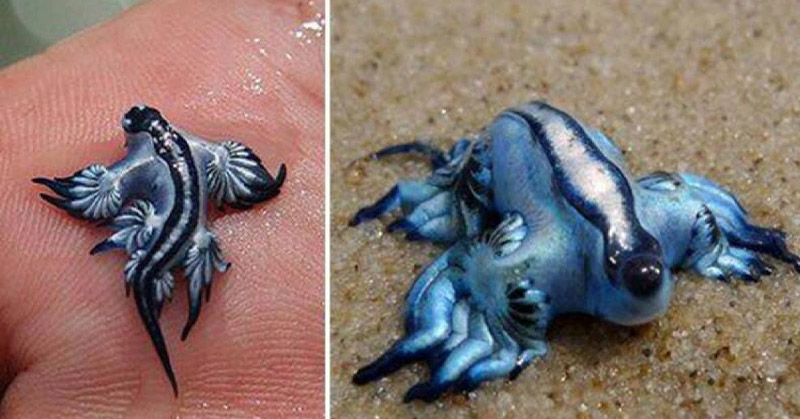The world is full of undiscovered mysteries and many of these seem to hide in the sea. During this pandemic, nature has tossed so many strange things our way, from bioluminescent beaches to wild animals trekking into cities. Now, a new otherworldly creature has entered the scene.
Blue dragons have washed up at the Padre Island National Seashore in the Gulf of Mexico. These brightly colored sea slugs are among the strange-looking animals that haunt the open oceans.
“Blue dragons are very small, generally only 3 cm, but don’t let their size fool you, they have a defense worthy of the name dragon,” a Facebook post from the national park said. “After eating, they move the stinging cells from the man-of-war to the end of their ‘fingers.’ Because they are able to concentrate the stinging cells together, their sting can be more painful than a man-of-war’s!” [1]
A Portuguese man-of-war looks similar to a jellyfish but it’s a carnivorous creature composed of multiple colonies of organisms working together. Their tentacles are extremely venomous and have given divers excruciating stings. [2]
These little sea slugs are a predator of the man-of-war. Once they consume the man-of-war, blue dragons take the cells that sting from their meal and place them on their extremities, ready for any threat to try and touch them. Sounds painful? The new good news is these blue dragons are rare. [3]
“So, if you see a dragon in the park, be amazed as they are a rare find, but also keep your distance!” the Facebook post concluded.
Read: Massive, deep-sea ‘entity’ leaves ocean scientists ‘blown away’
A Rare Encounter
A Texan family noticed several of these blue dragons at the beginning of May and took some pictures of the creatures in a green sand bucket before releasing them back into the ocean.
Leah Lane and her family were taking a trip from Mesa, Arizona, to Padre Island National Seashore when Hunter, her seven-year-old find the first blue dragon.
“We then went on to find four more throughout the afternoon. One washed up right next to my foot at some point, luckily I saw him and didn’t step on it,” Lane said. “Hunter really wanted to touch it, I don’t blame him, I did too, as they look very soft and squishy. But we discussed that since we have no clue what they are we better not. After thinking about it he even said ‘he might be like the poison dart frog mom, he is kind of brightly colored, which is a warning.’ Smart kid.”
A spokesperson for PINS explained that although blue dragons are rare, they have been showing up on their seashore. “A lot of people are finding them lately. That will often happen with animals, that a bunch will wash up at the same time.”
This is definitely a new occurrence. Lane commented that her husband Trey and she “spent three years camping out there, usually once a month or more, in college and neither one of us had ever seen one of these little guys.” [4]
About the Blue Dragon
These creatures are also known as blue glaucus or glaucus atlanticus, sea swallows, and blue angels. They can be found throughout the Atlantic, Indian, and Pacific Oceans in tropical and temperate waters. The blue dragon gets its venom from much larger prey like the Portuguese man-of-war and the blue button jelly. It sucks toxic chemicals or stinging cells from its prey into its own skin as a defense mechanism.
Despite its dangerous sting, the blue dragon is hardly much longer than 3 cm. It has a gas sack which allows it to keep its body afloat. The bright blue colors of its underbelly are camouflage against the ocean waves, while its gray back blends with the sea surface. Since the slug tends to float belly-up, it hides from predators above and below it.
A group of blue dragons floating together is known as a “blue fleet.” Blue fleets can wash up on shores and sting people swimming nearby, or be photographed in green sand buckets.
Little is known about the conservation status of blue dragons, as it is with other open water dwellers, but hopefully, these frequent sightings are a good sign for these beautifully-colored sea slugs. [5]
“They were fun to see and watch. They would fan out real big and then curl up, wiggle side to side. Very cool creatures,” Lane said.
They may be mesmerizing, but be cautious. “So, if you see a dragon in the park, be amazed as they are a rare find, but also keep your distance!” the PINS’ Facebook post concluded.
Keep Reading: Everything you need to know about the glowing Sea Turtle
[1] Padre Island National Seashore. https://www.facebook.com/nps.pais/posts/2902404533145964 May 6, 2020
[2] Portuguese Man-of-War. National Geographic. https://www.nationalgeographic.com/animals/invertebrates/p/portuguese-man-of-war/
[3] Ed Payne. Yikes! Venomous blue dragons wash up on Texas beaches. KLTV. https://www.kltv.com/2020/05/14/yikes-poisonous-blue-dragons-wash-up-texas-beaches/ May 14, 2020
[4] Mary Claire Patton. Beautiful but dangerous blue dragons discovered on Texas beach are ‘rare find’. KSAT. https://www.ksat.com/news/texas/2020/05/08/beautiful-but-dangerous-blue-dragons-discovered-on-texas-beach-are-rare-find/ May 8, 2020
[5] Blue Glaucus. Oceana. https://oceana.org/marine-life/corals-and-other-invertebrates/blue-glaucus

